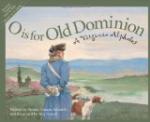[Illustration. A corner in the old graveyard.]
Peeping into a shed that temporarily covered the old chancel floor, we caught a glimpse of the mysterious tomb of the island. It is an ironstone tablet, once doubtless inlaid with brass, as the channellings for the metal are yet clearly defined. They show a draped figure and some smaller designs that have been taken as indications of knighthood, and have led to the conjecture that this is the tomb of Sir George Yeardley, governor of the Colony of Virginia, who died here in 1627. It is said to be the only tomb of the kind in America. Evidently, the stone has become somewhat displaced; for instead of being orientated as it must once have been, it now lies almost north and south.
We were not able to see the grave of William Sherwood, that humble but hopeful wrong-doer who lies under the chiselled words, “A Great sinner Waiting for a joyfull Resurrection.”
The old graveyard, like the hoary tower, awes the mind and touches the heart. And this partly because of its pitiful littleness. A handful of cracked and broken stones to tell of all that terrible harvest that Death reaped in the ruined village! But perhaps they tell it all as hosts of tombs could not do. One reads between the stones, then far out beyond them where mouldering bones are feeding the smiling fields; and there is borne in upon him the thought that our country had life through so much of death that this whole island is a graveyard.
After leaving the old tombs, we crossed a roadway and entered a ruined fort. In those few steps we made a long plunge down the years of history, and passed far away from old James Towne. None of the colonists ever saw those walls of earth. They are the remains of a Confederate fort. But, modern as they are, they have done what they could to put themselves in harmony with the ancientness all about. The slopes are grass-grown and even tree-grown. Within the walls is the caretaker’s cottage in the midst of such a wealth of trees, flowering shrubs, and vines as makes a greenwood retreat. The grass-grown embrasures and the drooping branches over them form frames for river views that seem set there in place of the rusty cannon pieces.
It was toward evening when we started back across the island, houseboatward. We sauntered slowly at first, turning for a backward glance at the old church tower and pausing again to look out over the water at the island’s outer sentinel, the “Lone Cypress.” We paused yet another time down where the marsh reeds lined the way. Grasping handfuls of the coarse grass, the Commodore started to illustrate how the colonists bound thatch, doubtless from that very marsh, to make roofs for their flimsy cabins. But the marsh furnished something besides grasses; and before the Commodore’s explanation had gone far, his auditors had gone farther. He valiantly slew the snake, the whole six inches of it, and hastening forward found those more progressive houseboaters safely ensconced in the shore-boat.




